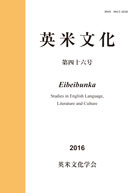Volume 31
Displaying 1-15 of 15 articles from this issue
- |<
- <
- 1
- >
- >|
-
Article type: Cover
2001 Volume 31 Pages Cover1-
Published: March 31, 2001
Released on J-STAGE: June 20, 2017
Download PDF (1415K) -
Article type: Appendix
2001 Volume 31 Pages App1-
Published: March 31, 2001
Released on J-STAGE: June 20, 2017
Download PDF (84K) -
Article type: Index
2001 Volume 31 Pages Toc1-
Published: March 31, 2001
Released on J-STAGE: June 20, 2017
Download PDF (27K) -
Article type: Article
2001 Volume 31 Pages 23-38
Published: March 31, 2001
Released on J-STAGE: June 20, 2017
Download PDF (981K) -
Article type: Article
2001 Volume 31 Pages 39-57
Published: March 31, 2001
Released on J-STAGE: June 20, 2017
Download PDF (1243K) -
Article type: Article
2001 Volume 31 Pages 59-81
Published: March 31, 2001
Released on J-STAGE: June 20, 2017
Download PDF (1356K) -
Article type: Article
2001 Volume 31 Pages 83-100
Published: March 31, 2001
Released on J-STAGE: June 20, 2017
Download PDF (1311K) -
Article type: Article
2001 Volume 31 Pages 101-115
Published: March 31, 2001
Released on J-STAGE: June 20, 2017
Download PDF (1018K) -
Article type: Article
2001 Volume 31 Pages 117-135
Published: March 31, 2001
Released on J-STAGE: June 20, 2017
Download PDF (1419K) -
Article type: Article
2001 Volume 31 Pages 137-149
Published: March 31, 2001
Released on J-STAGE: June 20, 2017
Download PDF (877K) -
Article type: Article
2001 Volume 31 Pages 151-168
Published: March 31, 2001
Released on J-STAGE: June 20, 2017
Download PDF (1112K) -
Article type: Article
2001 Volume 31 Pages 169-185
Published: March 31, 2001
Released on J-STAGE: June 20, 2017
Download PDF (1171K) -
Article type: Appendix
2001 Volume 31 Pages 187-
Published: March 31, 2001
Released on J-STAGE: June 20, 2017
Download PDF (91K) -
Article type: Cover
2001 Volume 31 Pages Cover2-
Published: March 31, 2001
Released on J-STAGE: June 20, 2017
Download PDF (74K) -
Article type: Cover
2001 Volume 31 Pages Cover3-
Published: March 31, 2001
Released on J-STAGE: June 20, 2017
Download PDF (74K)
- |<
- <
- 1
- >
- >|
